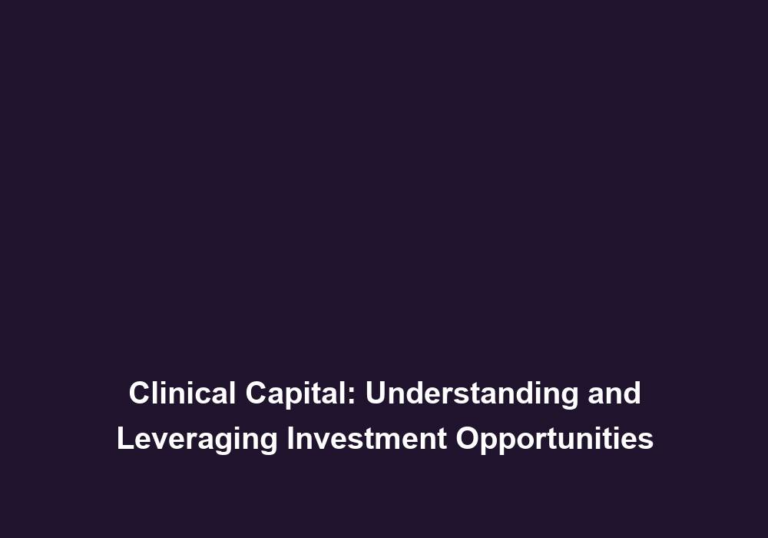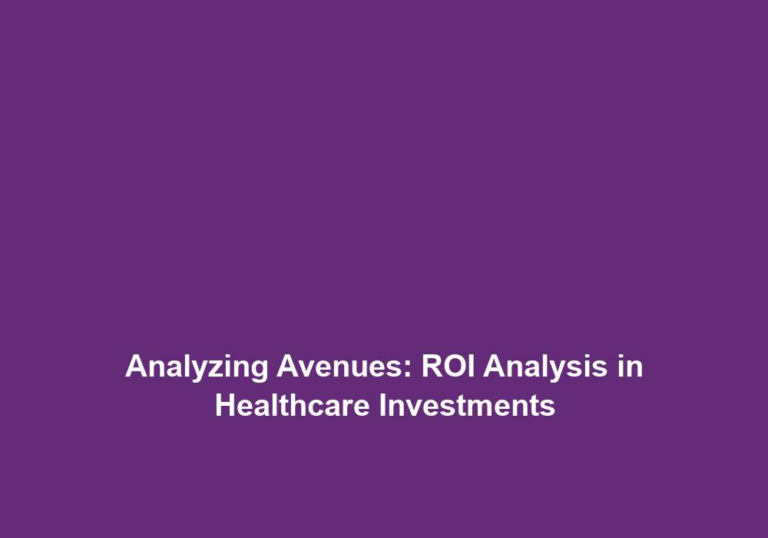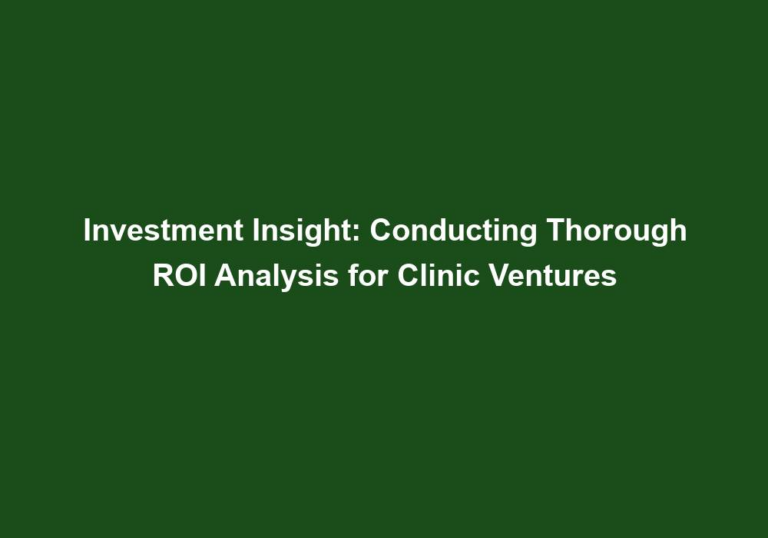ROI Revealed: Making Sense of Healthcare Investment Returns
Investing in the healthcare industry can be a highly profitable endeavor. However, understanding the returns on those investments can sometimes be challenging. In this article, we will delve into the intricacies of healthcare investment returns and provide you with valuable insights to navigate this complex landscape.
Understanding ROI in Healthcare Investments
Return on Investment (ROI) is a vital metric used to evaluate the profitability and efficiency of an investment. In the healthcare industry, ROI serves as a crucial indicator of financial success and sustainability. It measures the ratio of net profit to the initial investment, allowing investors to gauge the performance of their healthcare investments accurately.
To calculate ROI, you divide the net profit generated by the investment by the initial investment cost. For example, if you invest $100,000 and generate a net profit of $30,000, the ROI would be 30% ($30,000/$100,000).
Factors Influencing Healthcare Investment Returns
Several factors influence the ROI in healthcare investments. Understanding these factors is essential for making informed investment decisions. Let’s explore some of the key elements that impact healthcare investment returns:
1. Healthcare Market Dynamics
The healthcare market is a dynamic and ever-evolving landscape. To maximize investment returns, it is crucial to stay informed about market trends, regulatory policies, technological advancements, and demographic shifts. By actively monitoring these dynamics, investors can identify high-growth areas and capitalize on emerging opportunities.
Furthermore, understanding the competitive landscape within the healthcare market is vital. Analyzing the market share of different healthcare organizations and their growth potential can help investors make strategic investment decisions. By identifying organizations with a strong competitive positioning, investors can increase their chances of achieving higher ROI.
2. Risk and Reward Trade-Off
Like any other investment, healthcare investments come with inherent risks. It is essential for investors to carefully evaluate the risk and reward trade-off associated with each investment opportunity. High-risk investments, such as pharmaceutical research and development, may yield substantial returns but also involve greater uncertainty. On the other hand, lower-risk investments, such as medical equipment leasing, may offer more stable returns but with potentially lower profitability.
To effectively manage risk, investors should diversify their investment portfolio. By spreading investments across different healthcare sectors, such as pharmaceuticals, biotechnology, medical devices, and healthcare services, investors can mitigate the impact of industry-specific challenges and increase the likelihood of higher returns.
3. Technological Innovations
Technological advancements play a significant role in shaping the healthcare industry. Investments in cutting-edge technologies, such as telemedicine, artificial intelligence, and robotics, can significantly impact the ROI. These innovations can improve operational efficiency, enhance patient outcomes, and increase cost-effectiveness, ultimately leading to higher returns on investments.
For instance, telemedicine enables healthcare providers to reach a wider patient population, reducing the need for physical infrastructure and expanding revenue streams. Similarly, artificial intelligence and robotics can automate processes, streamline workflows, and improve precision in diagnosis and treatment. By embracing these technological advancements, investors can unlock new opportunities and drive higher ROI.
4. Regulatory Environment
The regulatory environment in the healthcare industry is complex and ever-changing. Investors must closely monitor regulatory updates and compliance requirements to ensure the profitability of their healthcare investments. Changes in regulations, such as reimbursement policies or drug approval processes, can significantly impact the financial outlook of healthcare investments.
To navigate the regulatory landscape effectively, investors should seek guidance from industry experts and consultants. These professionals possess in-depth knowledge of the healthcare industry and can provide valuable insights into regulatory compliance. By staying informed and adaptable, investors can mitigate potential risks and optimize their financial strategies.
Strategies to Maximize Healthcare Investment Returns
Now that we understand the key factors influencing healthcare investment returns, let’s explore some strategies to maximize ROI:
1. Conduct Thorough Due Diligence
Before making any healthcare investment, conducting thorough due diligence is crucial. It involves evaluating the financial health, competitive positioning, and growth potential of the target healthcare organization. Analyzing historical financial data, market trends, and the competitive landscape can help assess the viability and potential returns of the investment opportunity.
Additionally, conducting a comprehensive risk assessment is essential. By identifying and analyzing potential risks, investors can make informed decisions and develop risk mitigation strategies. Thorough due diligence is the foundation for successful healthcare investments.
2. Diversify Investment Portfolio
Diversification is a vital risk management strategy in healthcare investments. By investing in a diverse range of healthcare sectors, investors can spread risk and increase the likelihood of higher returns. Investing in pharmaceuticals, biotechnology, medical devices, and healthcare services allows investors to capitalize on different growth opportunities within the industry.
Furthermore, diversification provides a buffer against industry-specific challenges. For example, if there are regulatory changes impacting the pharmaceutical sector, investments in other healthcare sectors might help offset potential losses. By diversifying their investment portfolio, investors can achieve a balance between risk and reward.
3. Partner with Industry Experts
Collaborating with industry experts, such as healthcare consultants and financial advisors, can provide valuable insights and guidance. These experts possess in-depth knowledge of the healthcare industry and can help investors identify lucrative investment opportunities, navigate regulatory complexities, and optimize financial strategies.
Industry experts can also assist in conducting thorough market research, analyzing competitive landscapes, and assessing the potential risks and rewards of specific investments. Their expertise can significantly enhance the chances of maximizing healthcare investment returns and mitigating potential pitfalls.
4. Embrace Technological Advancements
To stay ahead in the rapidly evolving healthcare landscape, it is crucial to embrace technological advancements. Investing in innovative healthcare technologies can improve operational efficiency, enhance patient experiences, and drive higher returns.
For instance, adopting electronic health records (EHR) systems can streamline data management, reduce errors, and improve patient care coordination. Telemedicine platforms can expand access to healthcare services and enable remote consultations. Robotic-assisted surgeries can enhance precision and reduce recovery time. By leveraging technology, investors can unlock new revenue streams and drive higher returns on their healthcare investments.
Conclusion
Achieving optimal returns on healthcare investments requires a comprehensive understanding of market dynamics, risk assessment, technological advancements, and regulatory compliance. By analyzing these factors, implementing effective strategies, and leveraging industry expertise, investors can navigate the complexities of the healthcare industry and realize substantial returns on their investments. Remember, informed decision-making, diversification, and embracing technological innovations are key to unlocking the full potential of healthcare investment returns.






